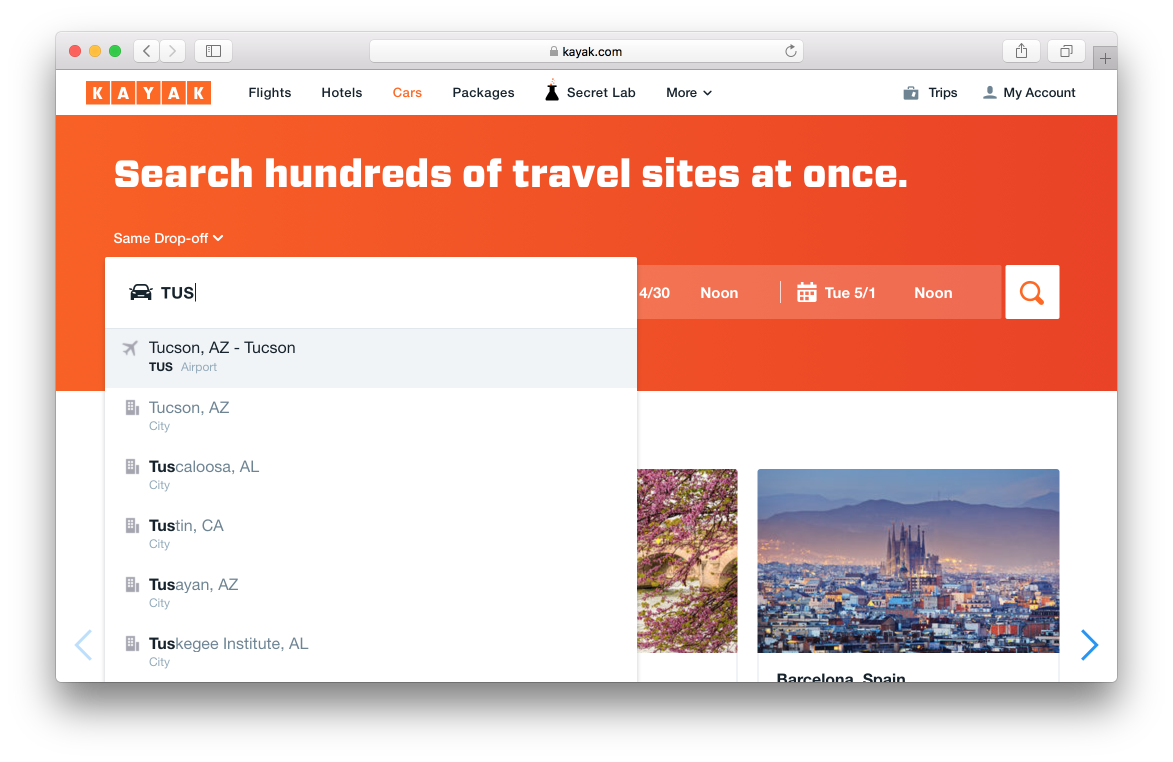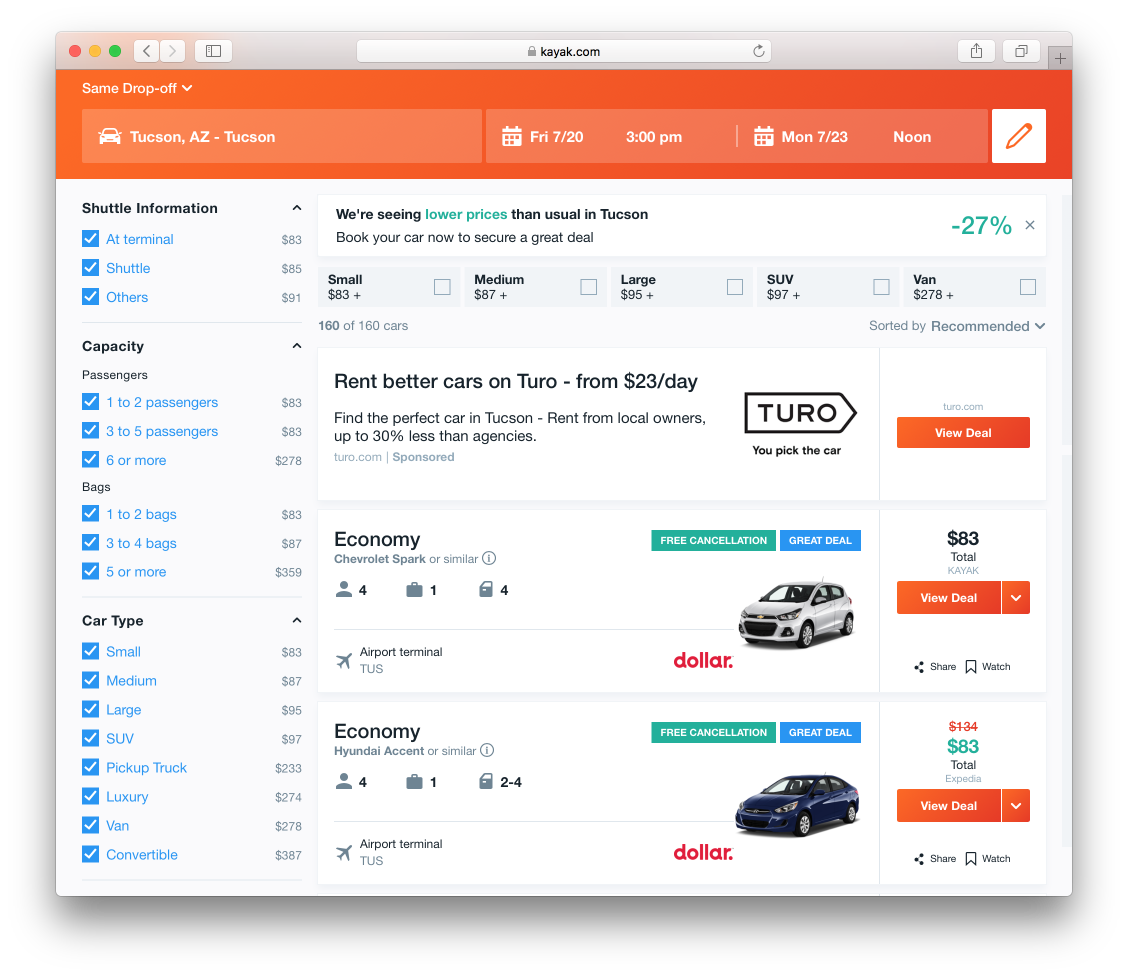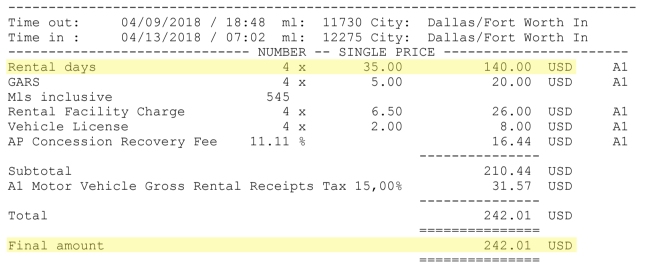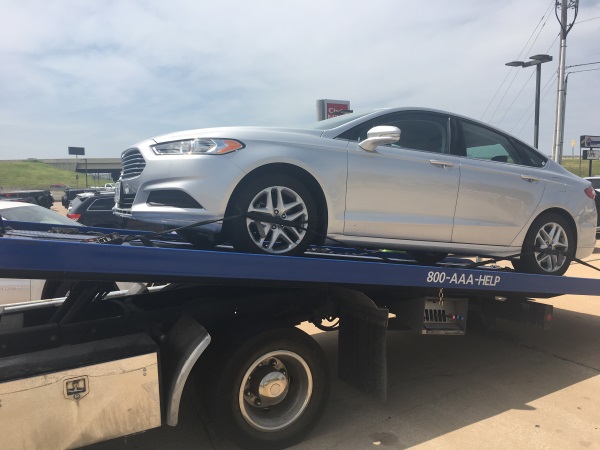I travel a lot for work and leisure, and I have rented hundreds of cars, so I’ve got some experience on the customer side of car rentals. I’ll try to help you out with what I’ve learned.
As most of my car rentals have been within the United States, this tutorial is U.S.-focused, but many of the tips may apply to rentals in other countries as well.
Table of Contents
Can I Rent a Car?
In general, if you are at least 25 years old and have a valid driver’s license (including non-US driver’s licenses) and a credit card, you can easily rent a car in the US.
Many car rental agencies will not rent to drivers under 25. Some places will rent to drivers that are at least 21, but they will generally add a large daily underage fee to those under 25.
Credit cards are the preferred way to pay for a rental car. Some places may take debit cards, but they will generally place a large hold on your card. They may also require that you have a ticket for a return flight that matches the date you’re planning to return the car. It’s much, much easier to use a credit card if you have that option. (Certain credit cards may also help you out with rental car insurance, as described in the Insurance section below.)
How to Rent a Car
If you have a particular car rental agency you want to rent from, you can go to that agency’s website. However, if you don’t care who you rent from, you can use pretty much any travel search engine. I generally use Kayak.
You can see in the screenshot below when I start typing an airport code, the search engine will offer me the choice between Airport and City.

If you’re flying in, you’ll generally want to get a car rental at the airport. Car rental agencies that are in the city you’re going to but not at the airport can often be cheaper; however, you’ll have to figure out how to get there and back, and that’ll often involve a pair of taxi rides that cost more than you save.
Select your pick-up location and time, and your drop-off time. Generally, I set my pick-up time to be within a half hour after my plane lands, and my drop-off time to be about an hour before my departure flight. Both times are approximate, but I like to set them for the longest I could conceivably have the car, since the longer you have the car the more you risk being charged for extra hours or days on your rental. (I’d rather have the car for a shorter duration than expected and have the final bill be slightly cheaper than the estimate, than have the car for longer than expected and have the final bill be higher than the estimate.)
Once you set your location and pickup times, you should see a bunch of cars to choose from:

There are a few things you’ll want to pay attention to here. First, in the upper left (and on specific cars), you’ll see it say Terminal, Shuttle, or Other. Terminal means that the rental car agency is literally on airport property (though, at some larger airports, not necessarily at the terminal); shuttle means it’s near the airport, but the car rental agency will provide you a free shuttle bus to and from the airport terminal. Ignore any cars that say Other, since they’re the ones where you’re on your own to figure out how to get there.
You can filter by size and type of car, as well. Different agencies call them different things, but here are the types of cars you can generally pick from:
| Category | Use |
|---|---|
| Economy | 1-2 people and I don’t care if I have cruise control |
| Compact, Small | 1-2 people |
| Mid-Size, Intermediate, Medium | 3-5 people, light packers |
| Full-Size, Large | 3-5 people, heavy packers |
| Van, Minivan | I care more about fitting the maximum number of people into the minimum number of vehicles than I care about my wallet |
| Anything else | I enjoy lighting money on fire |
The other thing to notice that most of the cars offer Free Cancellation. In general, most rental cars can be cancelled at any time without penalty (though some may still have you put in your credit card number when you make the reservation). However, sometimes you’ll see a rate that’s paid in advance (e.g. when you make the reservation), and you likely won’t be able to get a refund on those if your plans change. Just pay attention when you book so you know which you’re getting.
About Those Daily Rates
Be aware that you want to pay attention to the total cost, rather than the advertised daily rate. There are a ton of mandatory fees that the rental car agencies add in, and sales tax on rental cars is often very high (most of the people affected by a rental car sales tax are visitors who don’t vote in that district).
For example, here’s a receipt from a recent rental I had:

So the rental car agency would have advertised this rental at $35 per day ($140 for 4 days). However, once all the fees and taxes are added in, I actually ended up paying $242.01, or $60.50 per day—73% higher than advertised. Some airports have higher fees than others, but it’s always a substantial increase.
DO NOT TRUST THE DAILY RATE. EVER.
Fortunately, many travel search engines will show you the total rate with all those fees factored in—but just make sure you pay attention. Always, always, look for a final total cost.
Picking up Your Car (Beware of Fees)
Once you arrive, use the signs at the airport to find your way to rental cars or rental car shuttles (sometimes the airport signs will only point you to “ground transportation”), and head to the rental car desk. They’ll need to see your driver’s license and credit card. Then, they will try to upsell you on everything.
By the way, remember that 73% increase above the advertised rate in my example above? Those were only the mandatory fees and taxes. If I’d bought any of the below, the end cost would have been even higher.
Here’s some of the common things they’ll try to sell you:
Insurance
This is the big one. Car rental agencies will try to get you to buy extra insurance for the vehicle.
What they’re selling you isn’t the liability insurance required by law that you have to buy for your own car—they’re the owner of the vehicle, and they’re responsible for that (even though I’ve had rental agents outright lie to me in the past and say they aren’t responsible). You’ll typically find some sort of proof of insurance card in the glove box of any car you rent from any reputable agency, and regardless, if you get pulled over for some reason, you can generally just give the police your rental contract in place of proof of insurance.
Instead, the insurance that they’re trying to sell you is to protect the car itself—if you’re in a wreck with their rental car (or even if someone just dings the door in a parking lot), then the insurance they sell you ensures you won’t have to pay for repairing the car, and for the business they lose while the car is being repaired.
Being covered for damage isn’t a terrible idea itself—many people can’t afford to repair or replace someone else’s car—but like everything else in the world of rental cars, this insurance is overpriced, and you may be able to get it cheaper another way.
First, if you have your own car insurance at home, check with them to see if they cover rental cars. Some policies do if the car you rent is similar to the car you own (e.g. an insurance policy on an average car probably won’t cover renting a luxury car or a truck). Look through your insurance paperwork to see what they cover, or call your insurance company and ask. If your own car insurance will cover you, you likely don’t need to buy it from the rental agency.
Also, certain credit cards offer rental car coverage if you rent the car using their card. I have a Visa Signature card which covers me when I use it, but a number of other credit cards do as well. Check with your credit card issuer(s) to see if they offer any coverage.
If you don’t have coverage from anywhere else, feel free to buy it from the rental car agency—but don’t expect it to be cheap, as it’s generally an extra cost per day.
When you pick up the car, inspect it for damage, and if there is any damage be sure to let the rental company know before you take it off the lot. (It’s also a good idea to take photos of any damage before you leave.) Otherwise, you can be charged for damage the car already had. The general metric with damage is that if it’s a ding/dent/scratch smaller than the size of a U.S. quarter, they don’t care, but if it’s bigger than that you may be charged for it.
Prepaid Fuel
Normally, when you rent a car, they’ll give it to you with a full tank of gas, and you have to return it with a full tank of gas (so you need to fill it up somewhere near the airport before you return it). If you forget and return it with less fuel than you started with, they’ll charge you for the difference in gas — and they’ll often do so somewhere around $8–$11 per gallon. Do not forget to refill it.
However, most rental car agencies nowadays will try to offer you a prepaid fuel service, where you can pay in advance for the cost of a full tank of gas at something like 10 cents per gallon cheaper than what gas stations are charging—and then you can bring the car back empty if you want to.
They will try to make it sound like this is a great deal, but it’s really only a good deal if you can bring the car back completely empty. If you still have gas in the car, they won’t refund you for the difference. If you bring the car back half full, then you will have paid for a full tank of gas, and only used half a tank—It’s not a good deal.
Decline the prepaid fuel, and just fill it up before you return it.
Upgrades
Sometimes, at the counter, they will try to convince you to upgrade to a bigger or nicer car “for only $5 a day more,” or some price like that.
Just remember that when they offer, that $5 is on the advertised rate, and it’s per day. Using the example receipt I’d linked above, assume that $5 is 73% more expensive (not exact, since some of the fees are a flat daily rate rather than a percentage, but close enough for an estimate). That $5/day upgrade becomes $8.65 per day, or an extra $34.60 on my four-day rental. Not terrible, but not as cheap as they make it sound. And a lot of times, the boundaries between what’s, say, a midsize and a full-size car can become very fuzzy depending on what they have on the lot—so you may pay for an “upgrade” and then end up with the car that they were actually going to give you anyway.
Toll Transponders
Many toll roads around the country are going cashless—there is no longer a booth that you can stop at to pay. Instead, some places require a toll transponder, or some places will just photograph a license plate and send a bill to the owner of the car.
If you’re in a rental car, though, then that transponder or bill is the responsibility of the rental car agency, and they’ll charge you for the convenience.
Generally, if you use the rental car agency’s toll transponder (or let their license plate be photographed), they will charge you a “convenience fee” of something like $4.95 per day (for the entire duration of your rental, even days you don’t go on a toll road), plus the cost of the tolls. Because of the lag of communication between the tolling agency and the rental car agency, you may not get the bill for this fee until several weeks after you return the car, when it will just show up as am additional charge on your credit card from the car rental agency.
Some agencies in some cities have been switching to flat rate tolling—they’ll charge you something like $10–$15 per day, but you can go through all the tolls you want for that price. Because it’s flat rate, they will put it on your bill when you return the car, so you don’t have to worry about getting an additional charge later.
Either way, it’s generally easier to try to avoid toll roads when you’re in a rental car. If that’s not possible, however, make sure you ask the agency, so you know how much you’ll be paying.
Additional Drivers
Generally, only the person who rents the car is allowed to drive it. Your name will be listed on the rental contract, and if you let anyone else drive the car, any insurance you have is likely null and void if something happens to it. Similarly, if you get pulled over and the driver’s not on the rental agreement, the person driving is technically driving a car without the owner’s permission. So, if you’re going to want to share driving, you’ll need to add an additional driver to your rental.
The additional driver will have to meet the same requirements as the main driver (must have a valid driver’s license, likely must be at least age 25) and will have to be present when you pick up the car, so they can show the rental agent their driver’s license as well. There’s also likely a fee for an additional driver (although in many cases, the legal spouse of the renter can be added as an authorized driver for no additional fee).
Returning Your Car
If you didn’t purchase prepaid fuel, remember to fill up the car within a few miles of the rental car return location. (On the rare occasion where your car did not have a full tank when you picked it up, you can fill it up to the level it was at when you picked it up.)
Bring your car back to the same place you rented it from, unless you specifically made other arrangements on your reservation. If your rental location was at the airport (not an off-airport location with a shuttle), drive to the airport and follow signs for “Rental Car Return.” Remember what company you rented from, since when you get to the rental car return you will have to follow the signs for your specific rental agency.
At larger rental locations during business hours, the return lane will typically have employees out; follow their instructions on where to park the car, and they should check you in. At some smaller locations, you may have to bring the key inside to the counter where you picked them up.
If it’s after business hours, there may simply be a dropbox where you leave the key. When the rental agency opens up on the next business day, they’ll check in the car and email you a receipt.
Making Sure the Car Actually Gets Checked In
Even if your return is handled by an employee, most rental agencies will tell you they’ll check in the car soon and email you a receipt. I’d still recommend asking to get a paper receipt to force them to check in the car immediately. Though it’s rare, I’ve had two occasions where the car never got checked in, and I continued incurring charges until I was able to get everything sorted out with the rental agency and they found their car on their lot. Though both times I was eventually able to get it sorted out and the extra charges reversed, it took a few days and many phone calls to get resolved, and it’s generally a pain to deal with.
Sometimes the agencies still won’t let you get a paper receipt, and if you’re returning after hours it’s not an option anyway. In those cases, I’d recommend taking plenty of photos showing the rental car with its license plate visible in the rental agency’s lot. If you don’t get an emailed receipt within a day or two, contact customer support for your rental car agency and have them find out what’s going on, and keep a log of every time you contact them until the car return is resolved.
Other Tips
- Keep your rental contract in your car. If for some reason you need to demonstrate that you have permission to drive the vehicle (traffic stop, border crossing, etc.), the rental contract will function as your proof. Some agencies will send you an email with the contract instead of a printed contract; be sure you have that email before you leave the rental agency.

I had a rental car break down on one of my trips to Tulsa.
- If your car breaks down, call the rental agency to have them tow it away and get a replacement. If it’s something like a flat tire or locking your keys in the car, though, the rental agency may charge you for the roadside assistance. (However, if you have AAA, you can use it with rental cars too!)